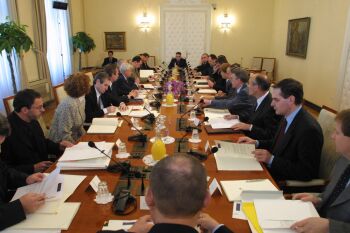
SIXTEEN HEADS OF STATE TO TAKE PART AT 9TH MEETING OF PRESIDENTS OF CENTRAL
EUROPEAN STATES IN SLOVENIA
Ljubljana, 23 April 2002
 The 9th Meeting of Presidents of Central European States is to take place in Slovenia on 31 May and 1 June 2002 on invitation from the President of the Republic, Milan Kucan, as was agreed at last year's meeting in Verbania (Lago Maggiore), Italy. Today President Kucan received the Ambassadors of the participating states to discuss the content of the meeting with them. The Presidents of all Central European States have confirmed their participation at the meeting, as did the majority of Presidents from the broader Central European region who were invited following an agreement at last year's meeting. The 9th Meeting of Presidents of Central European States is to take place in Slovenia on 31 May and 1 June 2002 on invitation from the President of the Republic, Milan Kucan, as was agreed at last year's meeting in Verbania (Lago Maggiore), Italy. Today President Kucan received the Ambassadors of the participating states to discuss the content of the meeting with them. The Presidents of all Central European States have confirmed their participation at the meeting, as did the majority of Presidents from the broader Central European region who were invited following an agreement at last year's meeting.
The ninth meeting, the largest and most important multilateral meeting ever to take place in Slovenia at this level, is to be attended by the heads of as many as sixteen states: Austria, Czech Republic, Hungary, Poland, Germany, Italy, Slovakia, the Ukraine, Moldova, Romania, Bulgaria, Croatia, the Federal Republic of Yugoslavia, Bosnia Herzegovina, Macedonia and Slovenia. In terms of the number of countries represented this year's will be the largest ever meeting of Presidents from the broader Central European region.
As agreed, this year the Presidents will focus on the role of Central European states in a uniting Europe and on the achievements of transition processes in these states. In a letter dispatched to the participants of the meeting the President of the Republic, Milan Kucan, proposed several topics for discussion on Europe's future, topics common to all states represented at the meeting.
President Kucan proposes for the Presidents to seek common answers to the questions of whether Europe is capable of enforcing its influence and taking on its own share of the responsibility for the future of a globalised world; is it ready to develop its own political identity enabling it to assume such a role; do EU and NATO enlargement processes already fulfil the need for a spiritually, politically, economically and security-wise integrated entity; will the Convention on the future of Europe yield the answers to these crucial questions; does the present European order, as shaped by the actions of the Allied coalition following World War II and by the fall of the Berlin Wall, offer sufficient protection to political democracy, stability, peace and security for the whole of Europe in such a way that opposing tendencies cannot pose a threat to these values; do the integration processes truly contribute to the overcoming of European political divisions and the prevention of new ones; is Central Europe capable of offering answers from its own experience to the questions concerning both Europe's and the world's future; is Central Europe capable of better helping in the transformation processes under way in South East Europe where security, equality among differences, democracy and prosperity remain distant values in the wake of bloody wars?
The aim of the meetings of Presidents of Central European states is to enhance the path for the most rapid organic and substantive amalgamation of the erstwhile political East and West based on the traditional values that European nations were formed upon. They offer an opportunity for discussion on the issues of European and global society and the bonding tissue represented by the system of values. These meetings were created at a time when the block division of Europe had broken down, yet its consequences remained. The number of presidents participating - having grown from the initial seven to sixteen - is proof of great interest in such cooperation.
More about meeting:
www.uvi.si/slovenija-summit/eng/
OFFICE OF THE PRESIDENT OF THE REPUBLIC

|







